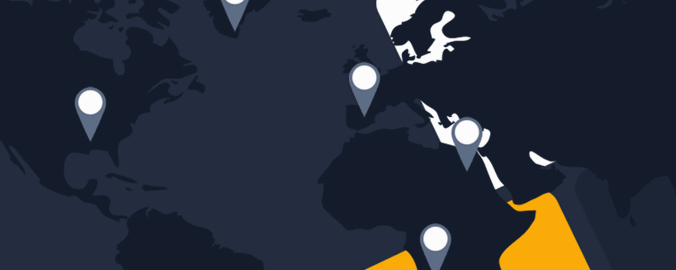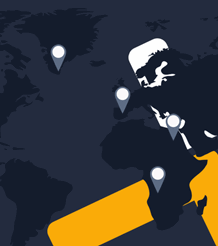
Australia Region Guide
Australia covers an entire continent of some 7,686,850 km2 and is divided into Western Australia, South Australia, the Northern Territory, Queensland, New South Wales and Victoria. It is the sixth largest country of the world covering one and a half times the land mass of the whole of Europe. Despite its landmass, Australia has the lowest population density of the world (2 people per km2). The population of circa 20.3 million is concentrated mainly in the coastal cities such as Sydney, Melbourne, Brisbane, Adelaide, and Perth, while the majority of the interior is desert and mainly uninhabited.
Located between the Indian and South Pacific Oceans, Australia benefits from a tropical climate in the north and a pleasantly temperate climate in the south. You can bask in warm sunshine for a total of 3,000 hours per year.
This democratic Commonwealth has only been in existence since 1901 when six separate colonies joined together to form the Commonwealth of Australia, ruled by Queen Elizabeth II. Australia boasts a prosperous Western-style economy with a strong growth rate.
When the British arrived and settled in Sydney Cove, it is estimated that 300,000 natives or Aboriginal people, speaking around 250 languages, inhabited Australia. Finding no obvious political structure, the Europeans took the land as their own and the indigenous people were widely massacred and driven from their homes. Meanwhile their plight became worse as various new European diseases spread rapidly among the Aboriginals, killing more. Fighting actually wiped out the Aboriginal population in Tasmania and greatly reduced their numbers in the rest of Australia.
During the early part of the 20th century legislation segregated the Aboriginals, restricting them on where they could live and work. After World War II, all rights were taken away from the Aboriginals in an ultimate attempt to 'Europeanise' them. During the 1960's, legislation was finally reviewed and the Federal Government allowed all Aboriginals to be given citizen status. In 1972 Aboriginals were finally given back limited rights to their own land and their situation has been steadily on a path of improvement ever since.
Natural Beauty
One of Australia's biggest attractions is its natural beauty. Landscapes vary from endless sun-baked horizons, to unspoiled beaches, to dense tropical rainforest. Australia is also famous for the remote outback of its interior with rugged mountain ranges and its vast deserts. It is in fact a country of vast contrasts that appeal to all tastes and should be taken into account when considering the acquisition of property in Australia.
As the Australian landmass separated from the other continents over 50 million years ago, indigenous animal species have developed within a unique habitat, creating an abundance of wildlife not found anywhere else in the world.
Climate
Australia features a wide range of climatic zones from the tropical regions of the north, the arid interior, to more temperate regions in the south. With an amazing average of 3,000 hours sunshine per year, the climate gives rise to a pleasant outdoor lifestyle and healthy living so popular among families looking to relocate to Australia.
Lifestyle
Foreign Office figures state that 800,000 British nationals visit Australia yearly and some 11,200 Britons emigrate there each year. They seek the classic Australian lifestyle: relaxed and with an abundance of outdoor living, beautiful beaches and a hot climate. They enjoy a wide variety of active pursuits, including swimming, fishing, cycling, jogging, bushwalking and more.
Culture
Scattered along the coasts, Australia’s cities blend a European taste for art and culture with food and a laid-back love of sport and the great outdoors.
Australia's cultural mix continues to diversify with more than 20% of its population having been born overseas. This gives Australia a rich diversity in its population and much of its character.
English is the national language and the legal and business environments are based on the British system, making a property purchase and relocation to Australia an easy option.
Accessibility
Around 30 airlines fly to Australia from the UK, including Quantas, BA, Malaysia Airlines, Singapore Airlines, Emirates (via Dubai), Royal Brunei and Thai Airways.
Flights time is approximately 18 hours from Europe and normally include a refuelling stop in Singapore or Bangkok. Prices will be high at Christmas so you will need to book your flight well in advance.
International Airports in Australia
Sydney, Melbourne, Brisbane, Adelaide, Perth, Darwin, Cairns and Hobart.
The sheer magnitude of Australia makes internal flights a good option for travelers within the country.
National Airlines in Australia
Quantas, Australian Airlines, Macair, National Jet, Rex Regional Express, Tasair and Virgin Blue and low cost flights connect with Australia’s airports:
National Airports
Brisbane, Broome, Cairns, Canberra, Darwin, Melbourne, Perth and Sydney.
Time Zone
+8 and +10 hrs GMT
Electricity
240 volts
Weights and Measures
Metric system.
Tel. Dialing Code
00 + 61
Australian Cuisine
The migrant mix to be found in Australia’s population has brought with it fine culinary specialties from many parts of Asia, Italy, Lebanon, Greece and even Scotland. Australia boasts an abundance of freshly grown produce, from a rich choice of tropical fruits to cold climate vegetables and it is even a major producer of rice. Its seafood, beef and lamb are well known to be among the best in the world and Australia’s location on the Indian Ocean means that seafood is well known to be fantastic.
Australians are food lovers and a proliferation of outlets sells food, from supermarkets and specialist delicatessens to every conceivable type of restaurant. Numerous cafes and bistros line the main streets in most towns and cities.
Although there is little authentic Australian cuisine, some typically Australian food such as the famous Australian meat pie is sold everywhere. Other authentic foods enjoyed in Australia are kangaroo, crocodile, emu and shark, while regional dishes include Sydney oysters, Tasmanian salmon and milk - fed lamb.
Australia is famous for its fine wines. Well known varieties include those from the Hunter Valley in New South Wales, Barossa Valley in SA or Coonawarra Valley in Victoria. The Swan Valley is Western Australia’s oldest wine growing region and grape varieties grown here include chenin blanc, verdelho, shiraz and chardonnay, all of which benefit from the region’s hot and dry climate.
Australian beer is the same consistency as lager and brands vary from state to state. Fosters is probably the most well known brand internationally while brands such as VB, Carlton, Tooheys and XXXX (Four X) are more often seen.
Food in Australia today is influenced by the large numbers of immigrants from Mediterranean, Asian and other countries and Australian cuisine now reflects its multicultural society. Once traditional dishes have been spiced up with new flavours to create new dishes. However, there are a few classic ones that have stood the test of time:
Australian Words - Equivalent
anzac biscuits - traditional biscuit/cookie dating back to World War I
bangers and mash - sausages and mashed potato
billy tea - bush tea boiled in a tin container
booze - alcohol
bundy - Bundaberg rum, eg 'bundy and coke'
champers - champagne
chook - chicken
cuppa - cup of tea or coffee
damper - bush bread
grog - alcohol
lamington - traditional small sponge cake squares covered in chocolate icing and sprinkled with coconut
lollies - candy, sweets
middy - medium sized glass of beer
pavlova - traditional meringue dessert
sanga - sandwich
schooner - large glass of beer
snag - sausage
stubby - small bottle of beer
tinny - can of beer
tucker - food
VB - Victoria Bitter, brand of beer
Vegemite - spread for toast or sandwiches, made from yeast extract
XXXX - 'four ex', Queensland brand of beer
Healthcare in Australia
Australian medical care runs differently from the UK. In Australia, patients pay their general practitioners for treatment and should a specialist be necessary, they must also pay for the consultation. In order to cushion the financial blow, patients can join one of about 110 medical and hospital benefit societies which then entitle them to Commonwealth subsidies towards medical costs. Pensioners however get free medical attention and drugs, and the doctor is paid by the government upon presentation of a voucher signed by the pensioner.
Hospital costs are paid by the government only for those patients who can pass a means test, but all hospital costs can be guarded against by insuring with a medical benefit society.
When the health benefits scheme, often known in Australia as the National Health Scheme, was introduced, the gap between benefits and fees was modest. However, steady inflation over the past 20 years, combined with increased complexity of medicine and treatments, has led to a constant rise in costs.
Most of Australia’s public health care is funded by Medicare, a good quality system that provides access to free treatment to Medicare patients, as well as subsidized private medical treatment from doctors and specialists.
Eligibility Requirements and Limits of Medicare
Australian citizens permanent Australian residents (who have permanent visas) New Zealand citizens people with applications for permanent visas under
People visiting or living temporarily in Australia generally do not have access to Medicare but there are some exceptions, such as:
Australian citizens who go overseas retain their access to Medicare for any return visits to Australia for up to five years from when they were last residing in Australia and visitors from countries with which Australia has a Reciprocal Health Care Agreement will gain restricted access to Medicare.
Nine countries (the United Kingdom, the Republic of Ireland, Finland, Italy, Malta, the Netherlands, Norway, New Zealand and Sweden) have reciprocal health care agreements with Australia. Visitors from these countries are eligible for Medicare assistance for any necessary medical treatment.
For people who are not eligible for Medicare, the private health care sector provides very high quality services. Private health insurance designed for their needs is widely available and you would be well advised to take out a policy if you cannot obtain Medicare insurance for general treatment.
The Royal Flying Doctor Service, founded in 1928 by the Reverend John Flynn, is unique to Australia. Providing a 24-hour a day service, 365 days a year aero medical emergency and health care service is available to people who live, work and travel in Australia's remote outback. From its seventeen bases, the Service's 38 aircraft fly over its ‘territory' of 7,150,000 square kilometers and cover almost 12 million kilometers annually.
Although probably best known for its emergency evacuation role, the Royal Flying Doctor Service conducts some 6 000 health care clinics each year, at which it sees about 117 000 patients. It continues to build on its primary health care role for the people of the outback. Consultations by doctors and nurses by radio and telephone with people at remote outposts are an important part of the service provided.
Financially, the Royal Flying Doctors rely on grants form the federal, State and Territory governments as well as funds donated by business, the corporate sector and the general public.
Useful sites for further information: Department of Health and Ageing - www.health.gov.au
and Medicare Australia - www.medicareaustralia.gov.au
Dial 000 for an emergency ambulance
Most tap water in Australia undergoes a range of treatment processes, making it safe to drink before it is distributed to taps for consumer use. However, many people still prefer to drink bottled water, particularly in the more remote areas.
Driving In Australia
Driving: on the left hand side
You need: valid driver’s license (in English) from your own country
The sheer scale of Australia involves some hundreds of kilometers between destinations, while distances for the unprepared can be surprising. Driving is an interesting and fun way to get about provided you carefully take into account the time it will take you to reach your destination.
Roads between the coastal cities and large towns are generally reliable and in good condition and these include the main highways. However remember that hundreds of kilometers may go by with no opportunities to re-fuel or buy refreshments.
Road conditions in remote areas and the outback can be difficult. Not all remote roads are sealed and may not be passable in certain weather conditions. With speed limits as high as 100 or 110 km per hour, they are not divided and have no barriers. 60% of accidents take place on these roads so you will need to drive slowly and be self-sufficient and prepared when travelling in remote areas.
Distances Between State Capitals
- Sydney - Melbourne
- 860km via the Hume Highway (National Highway 31) through Albury-Wodonga
- 1043km via the Princess Highway (National Highway 1) through Batemans Bay and Sale
- Sydney - Brisbane
- 964km via the Pacific Highway (National Highway 1) through Coffs Harbour
- 1018km via the New England Highway (National Highway 15) through Tamworth and Armidale
- Sydney - Adelaide
- 1410km via the Hume and Sturt Highways (National Highways 31 and 20) through Wagga Wagga and Mildura
- 1659km via the Mitchell and Barrier Highways (National Highway 32) through Dubbo and Broken Hill
- Melbourne - Brisbane
- 1681km via the Newell Highway (National Highways 31, 39, 42 and 15) through Dubbo
- Melbourne - Adelaide
- 724km via the Western and Dukes Highways (National Highways 8 and 1) through Horsham
- 912km via the Princess Highway (National Highway 1) through Mt Gambier
- Brisbane - Adelaide
- 2031km via the Newell, Oxley and Mitchell Highways (National Highways 15, 42, 39, 34 and 32) through Moree and Broken Hill
- Adelaide - Darwin
- 3019km via the Stuart Highway (National Highways 87 and 1) through Alice Springs
- Adelaide - Perth
- 2695km via the Eyre and Great Eastern Highways (National Highways 1 and 94) through Ceduna and Norseman
- Perth - Darwin
- 4166km via the Brand, North-West Coastal, Great Northern, Victoria and Stuart Highways (National Highway 1) through Roebourne and Katherine
Mobile phone coverage is often very intermittent, even on relatively major highways away from a nearby town, and nil in the outback. Currently CDMA phones are more likely to get reception than GSM phones. If you go to extremely remote areas, it is a good idea to buy or rent a two-way HF radio (the Royal Flying Doctor Service web page lists outlets they can be hired from) or a satellite phone.
Outback Driving
Outback driving calls for preparation and self-sufficiency as it is unlikely that anyone will be able to stop and help you should you break down. Towns, petrol stations and other amenities are scarce so you will need to make sure you carry adequate food, water and spare fuel. Australia’s interior consists of unadulterated desert, so if your car has no air-conditioning, you could suffer temperatures of 45°C (110°F) during the day and drastic temperature drops at nightfall.
You are required to go to the local police station before setting off the sealed (paved) highway and tell them where you intend to go and how long you expect to take so that they can come to the rescue if necessary should you become stranded. In the event of an incident when your car breaks down, never leave your car as it will give you shelter and it is a far easier to see than a person walking in the bush.
Be aware the gravel roads will be rife with potholes which are not always visible, especially when they are filled with bulldust (very fine sand particles) on sandy roads. These can overturn a car when passed over unseen. Corrugations are wavelike formations that form on a road surface after many cars have used it. At low speeds your car could be shaken dramatically and at higher speeds these corrugations can cause drivers to lose control completely, so be sure to maintain a speed of 70-80 km/h as a happy medium. In wet weather the bulldust sticks to tyres, filling the wheel cavity creating an overheated engine. Outback roads can be closed with little notice in the wet, isolating communities, at any time of year so it is advisable to pay attention to weather forecasts.
Speed Limits
Australians are strict with all rules of the road, especially speed limits, which are clearly signposted along the road sides.
In cities and towns, the speed limits often change and can be rather confusing. Standard roads have a limit of 60km/h, but in side streets and residential areas it is 50km/h. School areas have a 40km per hour speed limit during school hours. Speed cameras are becoming increasingly common in the capital cities, so be careful not to be caught on camera.
In rural Australia, the speed limit varies from State to State. In The Northern Territory the maximum speed limit on major highways is 130km/h and on other open roads it is 110km/h. In South Australia and Victoria the maximum for country areas and major freeways is 110km/h. The same applies for Queensland highways. In Western Australia the state "open road" speed limit is 110km/h, and generally 100km/h on freeways.
City Driving
As in any other cities of the world, it pays to avoid driving in or around the Central Business District (CBD) during peak times when excessive traffic congestion can be a problem. Major capitals usually have good public transport within the CBD and this is preferable to use for short distances.
Cars can be parked on the side of the road but normally involve a fee to be paid at a machine during certain times of the day or week. Commercial car parks also exist and are paid for on an hourly basis.
Driving in Melbourne’s CBD is known for its tram network and you will need to be aware of the rules for motorists here. Normally you are permitted to drive over the tracks in a lane denoted by a dotted yellow line, or tram lane.
Some Typical Road Signs
- NO STANDING. Don’t park or stop in this area except to let a passenger get in or out of a vehicle.
- NO STOPPING. Don’t stop except in the event of medical emergencies.
- NO PARKING. You can unload and unload passengers but cannot park your car there.
- BUS/TAXI ZONES. Do not drive your private car here.
- LOADING AND UNLOADING ZONE. If you’re driving a truck, ute, van or wagon, you may park here to deliver or pick up.
Crime and Police in Australia
Petty crime in Australia is most prevalent within inner cities and areas with a high proportion of aboriginal inhabitants where drink related offences can be numerous. However, as in many civilized countries, violent crime is a relatively rare occurrence and is limited to organised crime circles. Visitors are generally safe from criminal incidents provided they take common sense measures to avoid falling victim to crimes.
Crime and peacekeeping forces are organised by the Australian Federal Police (AFP) which enforces Commonwealth law and protects national interests from all types of crime. As a member of Interpol, it maintains liaison officers posted in at least 20 countries. On a domestic level, it also maintains inter State services to regulate domestic crime.
The ACT gives regular uniformed community policing services while Federal Agents work in plain clothes based in every Australian city.
Emergency Phone Numbers
In a life threatening emergency
Dial 000 and ask for the ambulance, fire or police service
Dial 106 for the Emergency Relay Service for people with hearing or speech impediments
Both these numbers can be called 24 hours a day, 7 days a week.



